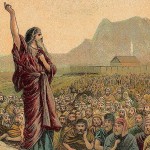Form or content? – D’varim
 Starting with the opening verses of D’varim, we become the audience for Moses’ series of farewell speeches.
Starting with the opening verses of D’varim, we become the audience for Moses’ series of farewell speeches.
Impressive to read, we wonder whether the orations were equally impressive to listen to. After all, Moses was marred by a speech impediment: he was k’vad peh, k’vad lashon, “heavy of mouth, heavy of tongue”.
The Midrash has a story about how Moses developed these problems, but that is a question for another day. For the moment, let’s ask what audiences are moved by – charismatic personality, silver-tongued eloquence, or sheer content?
The modern-day answer is probably the first and second, because television charisma is so important in popular culture. Body language, physical image, gestures and technique all influence our opinion of public figures. They might be saying the most banal things, and sometimes deliberately repeating slogans so that we begin to believe them.
An Australian politician kept repeating, “No GST (Goods and Services Tax)! No GST!” Then, after millions of people had believed him, he changed his tune…
In Moses’ time there was no TV and in any case the spokesman who put across the leader’s words might have had better speaking technique than Moses, but in his day it was probably the content that made the difference.
Whether we today can train people to examine content rather than form is a major question.



